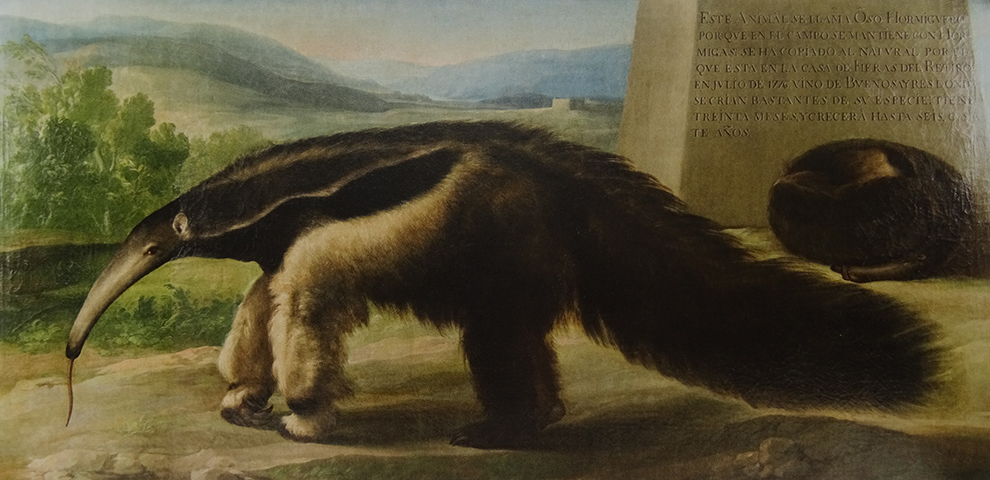In the striking exhibit of the Royal Cabinet of Natural History at the Museo Nacional de Ciencias Naturales in Madrid hangs a portrait of a giant anteater (Myrmecophaga jubata). This splendid painting, 1.05 m high by 2.09 m wide, depicts its monumental subject standing majestically in a mountainous landscape. The anteater’s shaggy black tail billows out behind it and its long tongue protrudes from its tiny mouth, almost touching the ground. The insectivore’s powerful foreclaws are clearly visible on its right foot, and it balances on its knuckles – an accurate representation of the way an anteater walks in the wild. A second anteater, smaller than the first, appears curled into a ball on the right side of the painting, its long snout tucked under its grizzled tail. The portrait of the South American insectivore was commissioned by King Charles III and painted in the studio of the court painter Rafael Mengs. According to the inscription on the stone plinth to the animal’s back, it was ‘taken from life in the Casa de Fieras in 1776’ when the anteater was 30 months old and still not fully grown. The painting thus represents the first living anteater to reach Europe, immortalising an exotic and little-known creature whose closest relatives are sloths and armadillos. It also depicts an animal that, in the late 18th century, would find itself at the centre of a heated scientific debate over the relative merits of New and Old World fauna.
HIS MAJESTY’S ANTEATER
Studio of Rafael Mengs, His Majesty’s Anteater, 1776. Oil on canvas (Museo Nacional de Ciencias Naturales; photo by H. Cowie).
Helen Cowie
Further reading
- Bleichmar, D. (2017) Visual Voyages: Images of Latin American Nature from Columbus to Darwin (New Haven, CT: Yale University Press/Huntington Library).
- Cowie, H. (2011) Conquering Nature in Spain and its Empire, 1750–1850 (Manchester: Manchester University Press).
- De Vos, P. (2009) ‘The rare, the singular and the extraordinary: natural history and the collection of curiosities in the Spanish Empire’, in Science in the Spanish and Portuguese Empires, edited by D. Bleichmar, P. De Vos, K. Huffine, and Sheehan, 271–89 (Stanford, CA: Stanford University Press).
- Dillon, J.T. (1780) Travels through Spain, with a View to Illustrate the Natural History and Physical Geography of that Kingdom (London:Robinson).
- Gerbi, A. (1973) The Dispute of the New World (Pittsburgh, PA/London: University of Pittsburgh Press).
- Gómez-Centurión Jiménez, C. (2011) Alhajas para Soberanos: los animales reales en el siglo XVIII: de las leoneras a las mascotas de cámara (Madrid: Junta de Castilla y León).
- Urríes y de la Colina, J.J. (2011) ‘Un Goya exótico, “La osa hormiguera de Su Majestad”’, Goya: Revista de arte, vol. 336, 242–53.
- Outram, D. (1995) ‘New spaces in natural history’, in Cultures of Natural History, edited by N. Jardine, J. Secord, and E. Spary, 249–65 (Cambridge: Cambridge University Press).
- Mazo Pérez, A.V. (2006) ‘El oso hormiguero de Su Majestad’, Asclepio, 58 (1): 281–94.
- Pimentel, J. (2017) The Rhinoceros and the Megatherium: An Essay in Natural History (Cambridge, MA: Harvard University Press).





